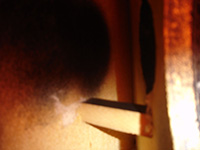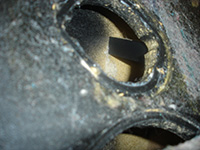Cabinet and Grill
Cabinets were made of medium density fiberboard (MDF) and covered in a variety of wood or vinyl veneers. On earlier boxes the black surfaces on the face and rear were painted, later units had a laminated paper-like finish. When damaged this stuff seems quick to peal.
I purchased an early set of TC-50s off eBay for parts and finding the grills were in better shape than mine went to swap them out, only to find they didn’t fit. In reading, Spica apparently used differing suppliers for cabinets and so the actual size may vary.
Internal Bracing
The later TC–50i cabinets included a front to back internal brace mounted beside the tweeter to stiffen the cabinet (reduce flexing). A similar mod was used in the Crosby Modified Spicas. Adding the brace stiffens the cabinet providing a clear mechanical advantage. The project only requires only basic woodworking skills and dissembling and reassembling the speakers presents only a small risk of damage.
Here are some photos of the factory in brace a TC-50i,
 |
 |
| Inside box looking up. The factory TC-50i brace mounts front to rear |
Same brace inside the right side of the tweeter cutout. |
Screw Hole Repairs
Stripped screw holes can usually be repaired by inserting a short length of toothpick into the hole. Dip the toothpick in glue and then slip it pointed-end first into the hole and then trim it off flush with a knife. Now when you drive the screw it will snug up. You should do this while the glue is still wet. The screw will act like a wedge to clamp the toothpick tightly to the wood while it dries. You can use two or more toothpicks if necessary. Larger holes can be restored by drilling the hole out to a larger standard size and inserting a correspondingly sized wooden dowel (fluted dowels are sold at hardware stores). When using a dowel, it is a good idea to go a couple of sizes larger than needed, then drill a pilot hole is drilled into the dowel for a new screw, there will be enough of the dowel remaining to hold the screw securely.

